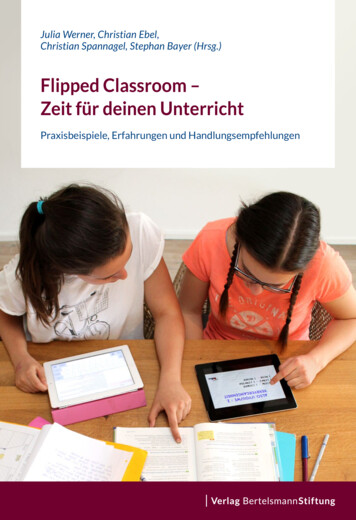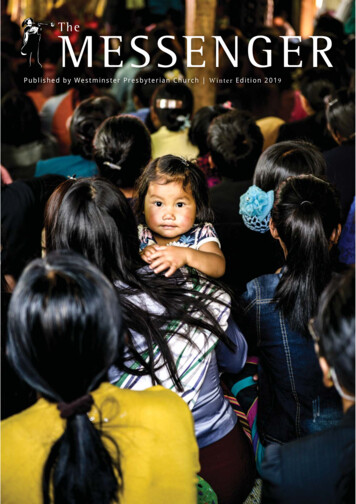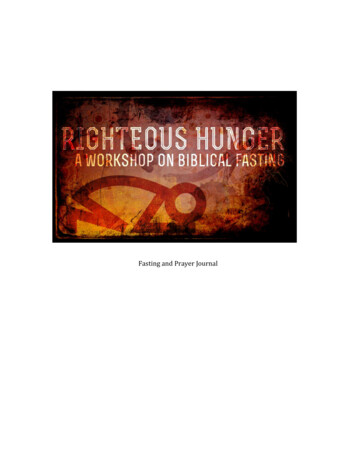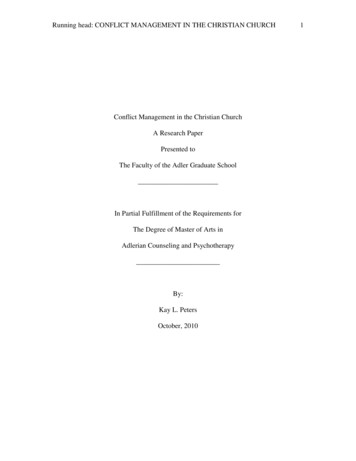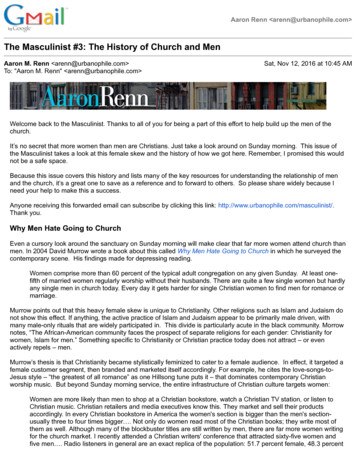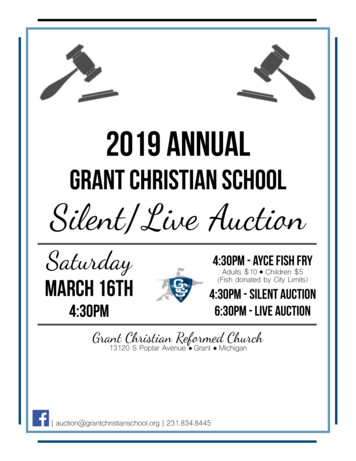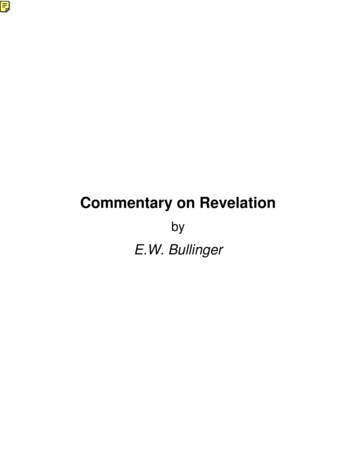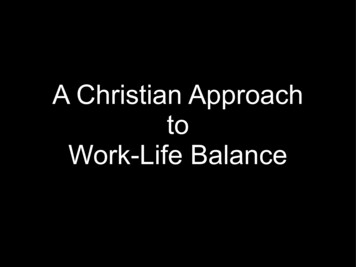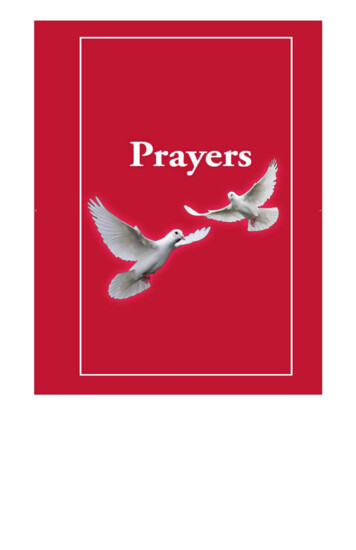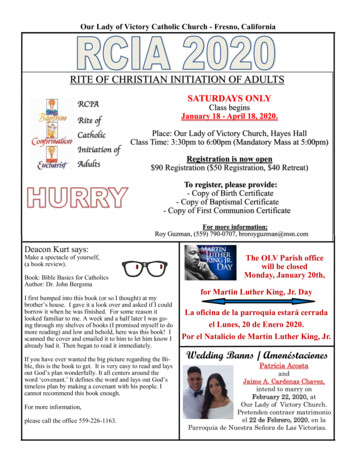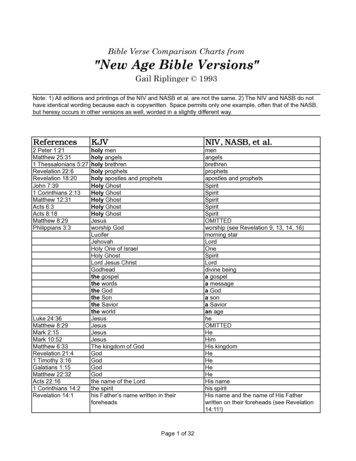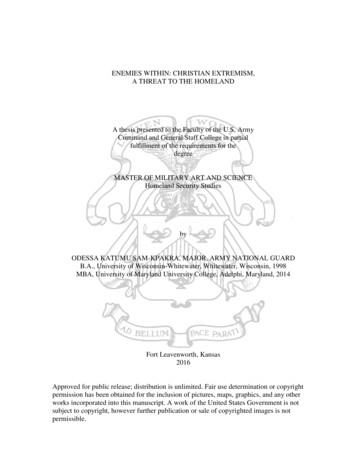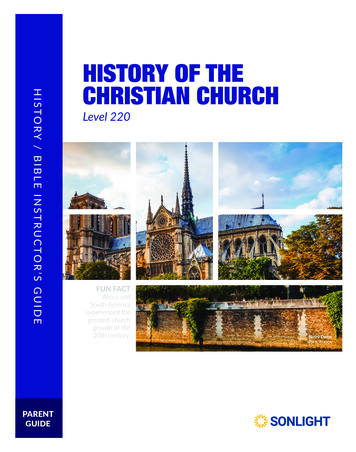
Transcription
HISTORY / BIBLE INSTRUCTOR’S GUIDEPARENTGUIDEHISTORY OF THECHRISTIAN CHURCHLevel 220FUN FACTAfrica andSouth Americaexperienced thegreatest churchgrowth of the20th century.Notre DameParis, France
I was feeling overwhelmed and afraid that I lackedwhat it takes to successfully homeschool my kids,” writesJennifer A of Battle Creek, MI. “I contacted an Advisor andgot the help I needed!”Contact a Sonlight Advisor today-FREECHATsonlight.com/advisorsCALL / TEXT303-730-6292EMAILadvisor@sonlight.com
220Ages 14–17Grades 9–11Bible/ApologeticsHistory & BiographiesHistory of the Christian ChurchBy the Sonlight TeamHow much better to get wisdom than gold, to chooseunderstanding rather than silver!Proverbs 16:16 (NIV)PARENT GUIDE
Sonlight Curriculum 220 “History of the Christian Church” Parent Guide,Fourth EditionCopyright 2015, and annually 2014–2020 by Sonlight Curriculum, Ltd.All Rights Reserved.No part of this publication may be reproduced, stored in a retrieval system, or transmitted in any form or by any means—electronic, mechanical, photocopy, recording, or any other—except for brief quotationsembodied in critical articles or printed reviews, without prior writtenpermission of the publisher. However, permission is hereby granted tothe original Sonlight Curriculum, Ltd. purchaser only to reproduce as manycopies of the Schedule Pages, Certificate of Completion, Life Skills CheckOff Lists, Field Trip Planning Sheets, and Additional Schedule Pages asnecessary for his or her immediate family’s use.“Do to others what you would have them do to you”(Matthew 7:12).“The worker is worth his keep” (Matthew 10:10).NOTE TO PURCHASERSonlight Curriculum, Ltd. is committed to providing the best homeschoolresources on the market. This entails regular upgrades to our curriculumand to our Instructor’s Guides. This guide is the 2020 Edition of the Sonlight Curriculum 220 “History of the Christian Church” Parent Guide andNotes. If you purchased it from a source other than Sonlight Curriculum,Ltd., you should know that it may not be the latest edition available.This guide is sold with the understanding that none of the Authors northe Publisher is engaged in rendering educational services. Questionsrelevant to the specific educational or legal needs of the user should beaddressed to practicing members of those professions.The information, ideas, and suggestions contained herein have beendeveloped from sources, including publications and research, that areconsidered and believed to be reliable but cannot be guaranteed insofaras they apply to any particular classroom or homeschooling situation.The Authors and Publisher specifically disclaim any liability, loss, or risk,personal or otherwise, incurred as a consequence directly or indirectly ofthe use and application of any of the suggestions or contents of this guide.Published bySonlight Curriculum, Ltd.8042 South Grant WayLittleton, CO 80122-2705USAPhone (303) 730-6292 Fax (303) 795-8668E-mail: main@sonlight.comPrinted in the United States of America.For the latest information about changes in this guide,please visit www.sonlight.com/curriculum-updates.Please notify us of any errors you find not listed on this site.E-mail corrections to IGcorrections@sonlight.com and anysuggestions you may have to IGsuggestions@sonlight.com.
Table of Contents1Introduction to Your Instructor’s Guide Table of Contents Introduction Instructor’s Guide Overview About—“History of The Christian Church” Bible Further Assistance2Schedule and Notes Sonlight Curriculum “History of The Christian Church” Schedule and Notes 2020 by Sonlight Curriculum, Ltd. All rights reserved.3Instructor’s Guide Resources “History of The Christian Church” Maps Why You Find Contradictions in History A Brief List of Magazines and Newspapers for Current Events Study “History of The Christian Church”—Scope and Sequence: Schedule for Topics and Skills Timeline Figure—ScheduleHistory of the Christian Church Parent Guide Section One 3
Table of Contents (continued)7Understanding the Structure of Your Guide7Study Guide Resource7Map Activities8Supplementary Websites8Corrections and Suggestions8Summary9Tips When Using the Internet 2020 by Sonlight Curriculum, Ltd. All rights reserved.4 Section One Parent Guide History of the Christian Church
Instructor’s Guide OverviewAbout “History of the Christian Church”We’ve designed your Sonlight Instructor’s Guide (IG) tomake your educational experience as straightforward andhelpful as possible. We have carefully organized your materials to help you and your children get the most out ofthe subjects covered. For help reading your schedule, seethe “How to Use the Schedule” page just before Week 1.Your IG includes an entire 36-week schedule of all thebooks you’ll read, followed by notes, assignments, readings,and other educational activities. For specific organizationaltips, topics and skills addressed, the timeline figure schedule, and other suggestions for you, take a look at some ofthe great resources in Section Three so you’ll know what’sthere and can turn to this section when needed.If you are new to Sonlight this year, please look in Section Four, where you’ll find helpful resources for new users including tips for getting organized, ideas for adaptingthe curriculum to your needs, record keeping suggestions,an overview of the structure of your Instructor’s Guide,and more.If you and your children are interested in discoveringmore about 2,000 years of Christian heritage, 220 haseverything you need. You’ll journey through the history ofGod’s kingdom, uncovering the story of Jesus and exploring key questions. What has God done throughout history?How is He moving today? How are we part of a globalbody of Christ that extends beyond our local churchesand denominations? 220 underscores the importance ofchurch history, giving us a more accurate perspective onChristianity.Several wonderful resources support the exciting goalsof 220 including The Story of Christianity, The 100 MostImportant Events of Christian History, The Church of the East,and From Jerusalem to Irian Jaya. The latter resource offersa fact-filled tour of the history of Christian missions including the early centuries in the Roman Empire, 20th centurymartyrs, third world missions, new methods and strategiesfor reaching the world, and more. 2020 by Sonlight Curriculum, Ltd. All rights reserved.What helpful features can you expect from your IG?First, everything you need is located right after yourschedule each week. If a note appears about a concept ina book, it’s easy to find it right after your schedule on theday the relevant reading is scheduled.Second, using the blank maps provided, students willplot assigned locations for each book. Map answer keys arelocated in Section Three of the Parent’s Instructor’s Guide.Third, your Instructor’s Guide includes a complete readyto-use 5-Day schedule, which has been carefully plannedto optimize use of the curriculum resources.Fourth, “To Discuss After You Read” sections help youhone in on the basics of a book so you can easily gaugehow well your children have comprehended the book. Thequestions are numbered to help you reference betweenthe Parent Guide and the Student Guide.Fifth, “Vocabulary” includes terms related to culturalliteracy and general usage terms [words printed in bold]in one easy-to-find place.Sixth, notes labeled “Rationale” contain informationabout specific books to help you know why we’ve selected a particular resource and what we trust childrenwill gain from reading it. Other notes marked with “Noteto Mom or Dad” will provide you with insights on moredifficult concepts or content from some books.Finally, don’t forget to have fun as you learn at hometogether!BibleAt Sonlight we take the Bible seriously. We believe theBible is the authoritative, inspired Word of God: ”All Scripture is God-breathed and is useful for teaching, rebuking,correcting and training in righteousness, so that the servant of God may be thoroughly equipped for every goodwork” (2 Timothy 3:16-17, NIV 2011).As a Christian curriculum company, our desire is tosee you and your children grow in spiritual maturity inChrist so that you can make a positive difference in God’skingdom. If you have your own Bible program you arefollowing as a family, we don’t want you to feel as thoughyou must drop it and stick to our approach exclusively. Butmaybe you’d like to give our method a try to see if you likeit and if it fits well with what you ‘d like to accomplish.You’ll find Instructor’s Guide Notes that will introduceyou to the Bible topics you and your children will cover.Please look these over ahead of time so you know what toexpect. In some sections we’ve also included Notes to address common questions or concerns. Whenever an issuearises where there are multiple viable explanations, we doour best to present all of them fairly and without tellingyou or your children which option to believe (we leavethose matters up to you, as the parent, to discuss withyour children as you see fit).In other words, we try to stick to what the PuritanRichard Baxter called “mere Christianity”—the core truthsthe church has always held throughout its history. Withthat in mind, Sonlight does have roots in Protestantism, sowe don’t specifically cover or assign readings from Biblebooks found in Roman Catholic and Eastern OrthodoxBibles that are omitted from Protestant Bibles. We are,however, respectful of various Christian traditions including Protestant, Orthodox, and Catholic.History of the Christian Church Parent Guide Section One 9
Enhancing 220’s emphasis on the history of the Christian Church are many important books such as the JoshMcDowell classic More Than a Carpenter. This short andprofound modern-day work provides a reader-friendlyintroduction to the reliability of the New Testament, thehistorical person of Christ, and our personal responseto his claims. In What if Jesus Had Never Been Born youand your children will realize the critically important roleChristianity has played in the history of the world via itsbenefits and influence on many areas of life. Other booksadd to the excitement of Christian truth and its importance including The Jesus I Never Knew and The Westminster Shorter Catechism.Our prayer is that you and your children will develop ahealthy approach to the Bible, its study, and its application to your own lives on a daily basis. To this end, each ofour programs seeks to integrate the Bible as a key aspectof learning and spiritual growth.Further AssistanceWe trust you will heartily enjoy your homeschool journey with your children. If we can be of further assistance,please don’t hesitate to contact us or visit our SonlightConnections Community (sonlight.com/connections). Thiscommunity of Sonlighter’s provides a place for you tointeract with other homeschoolers, seek advice, offer yourinsights, give words of encouragement and more.We also recommend that you visit sonlight.com/subscribe to sign up for our free email newsletter. When yousign up, you’ll receive regular homeschool encouragement, news, announcements and be the first to knowabout Sonlight’s special offers. n 2020 by Sonlight Curriculum, Ltd. All rights reserved.10 Section One Parent Guide History of the Christian Church
Section TwoSchedule and Notes
How to Use the ScheduleWrite in the week'sdate for your records.The symbolindicates you will finda map assignment inthe notes for that day.The d symbolindicates there is atimeline suggestion inthe notes for that day.Additional space foryour record keeping.More notes with importantinformation about specific books.The N symbol provides you with a heads-up about difficultcontent. We tell you what to expect and often suggest howto talk about it with your students.
220 Parent GuideDays 1–5History / BibleDate: toWeek 1Date:Day 1Day 3Day 2Day 4Day 5Bible/ApologeticsThe WestminsterShorter CatechismQuestion 1, plus answer all thequestions (#1–15)More Than a Carpenterchaps. 1–2Memorization Question 2, plus answer all thequestions (#1–15)Matthew 1:21Mark 10:45Luke 19:10History and BiographiesThe Story of Christianitypp. 7–11pp. 12–19pp. 20–23 The 100 Most ImportantEvents in Christian History 2020 by Sonlight Curriculum, Ltd. All rights reserved.pp. 30–35d Npp. 15–17“Titus DestroysJerusalem”pp. 26–30“Paul the Apostle”From Jerusalem toIrian JayaOptional:How to Read ChurchHistory, Volume 1Current Eventspp. 24–29 chap. 1Parents and Students: please read the notes for Current Events in the Notes for Day 1 this week.Other NotesBible/Apologetics—Introduction for ParentsWe believe students need to be prepared for the intellectual challenges to their faith that they will receive inthe years to come. Indeed, we believe they should notonly be prepared to face challenges; but also, to be so welltrained that they can challenge others in their faith (or lackthereof ).The Westminster Catechism is only one (of manyProtestant catechisms) that was produced in that periodof heavy theological ferment from about 1520 to 1650. Itincludes some idiosyncrasies that many evangelicals willobject to. If you are concerned about your children possibly being “polluted” by these Calvinistic and Presbyterianpeculiarities, we encourage you to find a catechism thatmight more nearly match your own views. At the sametime, we feel very comfortable recommending that youuse The Westminster Shorter Catechism as a jumping-offpoint for more thorough discussions, and teaching fromyour own perspective.You will notice we do this in our history study guide; wedo it also at many points with the The Westminster ShorterCatechism: we challenge, argue with, and critique ourmain textbooks. You can—and should—do the same.How should you use a catechism?We can recommend two methods.One is to take the catechism questions and answersalone and interact with what they have to say. Have yourchildren look up additional “proof texts” to bolster whatis being taught by the catechism or have them look up“proof texts” that seem to oppose what is being taught bythe catechism.N Note to Mom or Dad Map Point d Timeline SuggestionHistory of the Christian Church Parent Guide Section Two Week 1 1
The other method makes greater use of the study guidethat goes along with The Westminster Shorter Catechism.We believe the best answers to the study guide questionsshould be presented in writing. If your children disagreewith Williamson’s answer or if they rebel at the question,please encourage them to write out how and/or why theydisagree or feel offended. In this way, they will be sharpening their own perception and discernment skills.Besides The Westminster Shorter Catechism, we haveincluded three “apologetics” works.Kennedy’s What if Jesus Had Never Been Born? is what wecall a historical apologetic; it seeks to lay to rest many ofthe historical claims made against the Church. In fact, ittakes the offensive and shows the great cultural achievements of Christians and Christianity through the centuries.More Than a Carpenter offers a pretty rigorouspresentation of basic evidences for Christian faith in apopular style.The Jesus I Never Knew is a unique study of Jesus andthe life he lived, written by the thought-provoking PhilipYancey. Our prayer is that this work enables you to meetJesus in a new way.If there is one thing that sets Sonlight Curriculum apartfrom all other curricula you could purchase, it is our viewof and approach to history.From the very earliest grades you can see that we havea greater interest in the whole world than most of thecurriculum suppliers do. We have this international focusbecause, as wonderful as the United States and Westerncivilization are, we know that God’s purposes extend farbeyond our borders. As scripture says, “God’s plan fromthe beginning has been to acquire a people for Himselffrom every tribe, tongue, people and nation“(Gen. 12:2-3;Rev. 5:9; etc.). Therefore, we have chosen materials thathelp children understand their responsibilities as “citizensof a heavenly kingdom” in the midst of the world.There is more to our concern for history, however, than adesire to give children an international perspective.Some Christians bemoan the fact that the spiritualdimension is left out of most history texts; Christians arenot accorded their proper place in history books; we donot see the influence of Christian ideas on the course ofhistory; we do not have enough Christian biographies instandard history courses. Sonlight Curriculum, Ltd. hastried to address each of these shortcomings.But beyond these concerns that center on theChristian influence in history, we believe we need to ask,“What is God doing in history? What is He doing at this (orthat) point in history to bring about His overarchinghistorical purposes?”You may have heard that history is “His story.” Sadly,what most Christians seem to mean by that is merely thatGod is sovereign; He controls what happens in all theevents of history. This is “sad” because the simple fact thatevents are controlled by God doesn’t mean that when allthe events are put together they make a story. And, in fact,Specific Recommendations for Teaching History and BiographiesIf you’re one of those parents who doesn’t need to “bethere” with your children while they read most books,you’ll still want to keep up with what they’re reading. (Perhaps you can do the reading at night while your childrenread during the day.) You have more experience in life andknow more than your children about the Bible, history,historical trends, and the way all these things interact.With this base of knowledge and experience, you shouldbe able to point out connections between the variousthings your children are reading—connections that theywould never catch on their own.One of the best ways to help your children in this area isby asking questions that will help them find these connections on their own. “Do you see any way that the persecution of Christians in would have actuallyhelped spread the Gospel (see Acts 8:1, 4)?” Again, interactwith your children. It’s important.The Westminster Shorter CatechismDay1-2Question 1 (#1–15)Read question 1, plus answer all the questions (#1–15).#1 What is meant by the word “chief” in theCatechism? man’s one thought and desire is to serveGod and take delight in Him#2 What is meant by the word “end” in the Catechism? goals, aims, purposes#3 What is meant by the word “glorify?” to reflectGod’s glory#4 Why is man’s chief end what the Catechism says thatit is? the Word of God declares it: 1 Corinthians 10:31; Revelation 4:11; Psalm 73:25, 262 Week 1 Section Two Parent Guide History of the Christian Church 2020 by Sonlight Curriculum, Ltd. All rights reserved.History & Biographies—Introduction for Parentswe know of few people who seek to reveal God’s purposein history (all history) or how He has pursued this specialpurpose down through the centuries.Unless we believe there is an end toward which historyruns, history has no plot. History may be His, but it is notHis story. God’s goal in world history is to reestablish Hisrightful place as King of kings and Lord of lords amongall nations.You can help your children immeasurably:By asking questions. “What people did you read abouttoday?” “What did they do?” “Why are they important?”“When did they live?” “Did they make an impact that is stillbeing felt today? If so, how?”By suggesting or pointing out historical (includingBiblical) parallels. “That sounds like what you were sayinghappened with John Paul Jones.” Or, “Didn’t the Egyptianshave a belief like that?”By admiring your children and the work they are doing.“I’m impressed!” “Where did you learn that?!” “I didn’t knowthat!” “That’s great!”
#5 Man, as originally created, wascentered. GOD#6 Man, as he became by sin, centered. self#7 What do we mean by saying that the true Christian lifeis God-centered? only the person who truly believesin the Lord Jesus Christ can glorify God and enjoyHim forever#8 What would some people put in the center of figure1.2 rather than the word “self?” the good of man#9 Why is this really just as bad? it is not God-centered;it is man-centered#10 What does “glorify God” not mean? to makeGod glorious 2020 by Sonlight Curriculum, Ltd. All rights reserved.#11 What is the difference between the way in which theheavens glorify God and the way in which man oughtto glorify God? the heavens cannot help but declarethe glory of God; man is given the wonderful privilege ofdoing it because we want to do it#12 Do the wicked glorify God? Explain. yes, he stillremains subject to God; God’s wrath and justice can beseen and honored#13 Is it proper for a Christian to have other “ends” besidesthe end of glorifying God? no, the Christian glorifiesGod at all times and in all activities to do that which ispleasing in God’s sight#14 What departments of life ought to serve the glory ofGod? the true Christian life cannot be divided up intovarious departments or compartments separated theone from another. All departments of life ought to servethe glory of God#15 Which is more to the glory of God: a person whopreaches or a man who works in a factory? Explain. faithful work and wholesome recreation are just asmuch a part of glorifying God as worshipping God onthe Sabbath, or witnessing to an unbelieverDay4-5Question 2 (#1–15)Read question 2, plus answer all the questions (#1–15).#1 What is meant by the word “contained” in theCatechism? the very words in the Bible are from God#2 What is meant by the word “scriptures?” specialrevelation, the Word of God#3 What is meant by the word “rule?” that which teaches men what they must believe (in order to be saved fromsin) and do (in order to serve God once more)#4 Are the educated and intelligent more certain toknow God’s truth than the uneducated and simple?Why? no, some of the most intelligent and besteducated people lack true wisdom; true wisdom can begiven to any man regardless of his education#5 Was man’s knowledge originally supposed to comefrom nature alone? no, nature only taught man thatthere is a God; the Bible was given to show man how tolearn about God#6 What are the two sources of “truth?” natural revelation and special revelation#7 What is the principle of the so-called “scientificmethod?” the “trial and error” method ofdiscovering truth#8 What does natural revelation alone (by itself ) nowdo for all men? it reveals God and leaves manwithout excuse#9 What does Liberalism mean when it says the Bible“contains” the Word of God? some parts of the Bibleare the Word of God, and that other parts are the wordof man; they can decide for themselves which part is trueand which part is false#10 What does Neo-orthodoxy mean by saying this? new Modernism; the whole Bible is the fallible word ofman; God somehow uses these words so that throughthem man receives (in his own mind) the true word ofGod; one part may “speak” to one man and another part“speaks” to another man#11 What does Reformed Christianity mean by sayingthis? they believe that the whole Bible (every singleword) is the truth of God#12 What do you mean by saying the Bible is infallible? everything that the Bible says is true#13 What do we mean by saying it is clear? Who (for example) denies this? the scriptures were written so thatordinary people and even children could understand#14 What do we mean by saying it is sufficient? Whodenies this? we do not need something else in addition to the Bible in order to know what we need to know;many false religions deny this; they say we need tradition, the findings of science and other books#15 If the Bible is what we say it is, why do we have theCatechisms? the Catechisms are convenient summaries of the teaching of the BibleMore Than a CarpenterDayALLChapters 1–2Over the course of this week, read Chapters 1 and 2.History of the Christian Church Parent Guide Section Two Week 1 3
MemorizationDay1Matthew 1:21The Story of ChristianityRationale: Knowing definitions is critical to understanding. That’s why we’ve included important vocabularyterms in your Instructor’s Guide. More common termsthat your children may not know are listed first, followedby, where applicable, cultural literacy terms that providedepth to stories but may not be commonly known. Readthe vocabulary sections aloud to your children, then havethem guess the meanings of the bold italic words. Seehow your children’s definitions compare to the definitionswe provide. From time to time you and your children mayalso want to look up words in a dictionary to comparewhat other sources offer as definitions.1pp. 7–11Vocabulary” the Messiah, the son of the living God.” (the anointedone, expected king, and deliverer of the Hebrews) most importantly the Mass, or the Lord’s Supper (public celebration of the Eucharist in the Roman CatholicChurch and some Protestant churches) a need to codify the basic tenets of the ChristianChurch (to arrange or systematize) from barbarian invasions and the rise of Islam (a religion characterized by the doctrine of submission to theone God and to Muhammad as the chief and last prophet) gaze in awe at Michelangelo’s frescoes on the ceiling (art made by painting on fresh, moist plaster)To Discuss After You Read1. The authors say, “Today one-third of the world’s population call themselves Christians.” The rest of the world’spopulation includes various Muslim sects, Hinduism, Buddhism, Judaism, Tribal religions, Chinese folkreligions, or no religion at all. Why is this important? first, because it demonstrates the broad effect of Christianity around the world since the time of Christ; second,because it shows the great need for continuing missionsaround the world today2. According to the authors, what is (and always hasbeen) the source of motivation for Christians to loveothers and live better lives? gratitude to Jesus Christ;a desire to be like Jesus Christ3. What do they say is the motivation to undertake Christian missions? the command to “go and make disciplesof all nations”1 Matthew 28:19 (NIV)4. Why is it important to know that Christianity “ is areligion with distinctly Jewish origins?” to understandthe beginnings and the history of Christianity, we mustknow something about Jewish history—the roots ofChristianity5. Why did Mahatma Gandhi say, “I love your Christ, butnot your Christians?” because self-proclaimed Christians had caused great pain among his people6. What is the geographical location of the greatestnumber of Christians today? Africa, Asia, and SouthAmerica1. The term “nations” in Greek is ethné (ETH-nay), which means “ethnicgroups” or “peoples.” That definition is much broader than defining nations by political boundaries. Within each “nation” there are many “ethnic/people groups.” (Depending on how you want to split things up, there arebetween 3,000 and 10,000 ethnic or people groups in the world today.)4 Week 1 Section Two Parent Guide History of the Christian Church 2020 by Sonlight Curriculum, Ltd. All rights reserved.During this year’s study you will have the opportunityto memorize and quote various texts of Scripture. Thememory verses are taken from the Bible reading list foreach week, and more often than not, are key verses in theportion of the New Testament you will read for the week(the assignments for Week 1 and Week 36 have threememory verses, but all the other weekly assignments haveonly one memory verse). We want to encourage threethings with reference to your memory work:Be diligent in the memory work. Take seriously the valueof committing passages of Scripture to memory. You willbe surprised at the end of the year how much Scriptureyou have memorized.Don’t just memorize words, but endeavor to understandthe meaning of the words you memorize. If you comeacross terms you do not understand, look them up. Inorder fully to understand what a verse means, it is at leasthelpful (if not essential) to consider the context in whichyour memory verse resides. Try to read before and after tosee the “contextual setting” of the verse(s).You will be assigned to quote your memory versesaloud at the end of Weeks 12, 24, and 36. Preparation forthese quoting assignments will enable you to commit tomemory some important biblical passages, and quotingthe passage aloud will enable you to practice some publicspeaking skills.Day
Day2Daypp. 12–193VocabularyVocabularyThese promises, known as the Abrahamic Covenant (see Genesis 12:1–3; the promises of God made to Abrahamin Scripture) when the Jewish canon was determined (the booksof the Bible officially accepted as Holy Scripture)The Code of Hammurabi (an entire body of laws, arrangedin orderly groups, written by the King of Babylon)The Ark of the Covenant (sacred chest where theancient Hebrews kept the two tablets containing theTen Commandments) they like the Israelites, were of Semitic ancestry (anadjective that describes things originating from the AsianMiddle East2) 2020 by Sonlight Curriculum, Ltd. All rights reserved.pp. 20–23The Hellenization of the Eastern world was so complete (to make Greek in character, culture, or civilization)Their effort is known as the Septuagint (a Greek versionof the Hebrew Scriptures) collectively known as the Old Testament Apocrypha.(certain writings which are received by some Christians asan authentic part of the Holy Scriptures, but are rejectedby others)The Israelites were forced to build the cities of Pithom (one of the “treasure” cities built for Pharaoh Rameses II) celebrated today by Jewish communities and is calledHanukkah (an eight-day holiday commemorating therededication of the Temple of Jerusalem)The Israelites were forced to build the cities of Pithomand Rameses (one of the “treasure” cities built forPharaoh Rameses II)To Discuss After You ReadIsrael and Judah had repea
History & Biographies History of the Christian Church By the Sonlight Team 220 Ages 14 17 Grades 9 11 PARENT GUIDE. . scribe to sign up for our free email newsletter. When you sign up, you’ll receive reg
